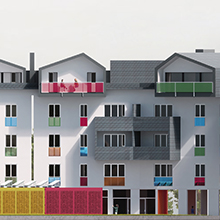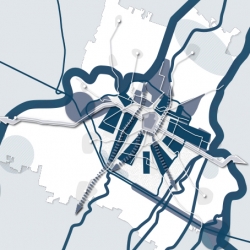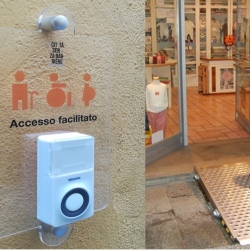
ATER Umbria and the Municipality of Perugia have also drafted PINQUA PS5G concerning the redevelopment project of the former Palazzetti area in Ponte San Giovanni, based on five synergic actions (subtraction, addition, overlapping, naturification, diversification) aimed at affirming the sustainable vocation of the intervention.
The ATER Umbria and the Region of Umbria drew up the PINQUA ‘Living Umbria’ and ‘Upper Umbria 2030’.
The programmes concerned the infrastructural axis of the Central Umbrian Railway, through the redevelopment of the buildings and spaces connected to the railway, and the inter-municipal territory between the municipalities of Upper Umbria (municipalities of Citerna, Città di Castello,…

Ecological and digital transition, urban and environmental quality and local strategies to support the health and wellbeing of citizens, to address the critical issues of the territory: these were the starting points that guided the definition of the vision and elaboration of the new Plan. The WYP proposal, adopted by the Modena City Council and soon to be adopted, constitutes the frame for a compact, attractive, innovative and environmentally sustainable city and is made up of five components, whose circular and intersecting relationships constitute the necessary reference for the government of the territory.
Strategy, Discipline, Knowledge Framework, ValSAT and Constraints…

Reggio Emilia City Without Barriers’ (RECSB) has been running since 2015. The project pursues the political mandate to act a transversal and inclusive cultural horizon, with the aim of creating a city that is attentive to the rights of the most fragile people, that eliminates the causes of marginalisation and discrimination, and that is hospitable and beautiful. The main objective is to approach integrated processes of sectoral policies with the direct involvement of citizenship.
The areas of intervention relate to institutional, study and research actions for: the welcoming and accessible city; barrier-free culture, art and fragility; community awareness of the…
Giulia Fini, Università di Udine, Valeria Saiu, Università di Cagliari, Claudia Trillo, University of Salford
The UPhD GREEN conference is dedicated to research conducted within doctoral programs that address the topic of sustainable development, with reference to spatial planning and urban environment design. The fifth edition of the conference calls on doctoral students to present strategies, projects, tools and evaluation models for the sustainable development of cities and the territory, through concrete application experiences. More emphasis will be given to research that promotes forms of collaboration with public agencies and administrations, social enterprises, third sector entities and…
Gianni Biagi and Ennio Nonni, INU – URBIT
The year 2022 is certainly to be regarded as the year that marks the new point of view on the subject of energy; the changing climate with serious repercussions on water resources and the ongoing war that repositions the way in which energy is supplied, place this issue at the apex of the challenges to be faced immediately, also with regard to the life of cities.
Less energy at higher costs, with uncertain prospects, sends cities suffering, as they lose economic competitiveness, planning and ultimately attractiveness.
The path undertaken over the last ten…
Massimo Rossetti, Università Iuav di Venezia and Gianni Biagi, INU – URBIT
Through the presentation of projects, companies and ideas, the conference explores the field of new materials and technological innovations capable of improving the energy performance and environmental comfort of both buildings and homes, helping people with psychophysical disabilities to live independently in their homes.
Often these are innovations born from simple ideas such as the use of wood and the environmental comfort ensured by this material to create the interior of multi-sensory environments for people with disabilities, or the recovery of waste from rice…


